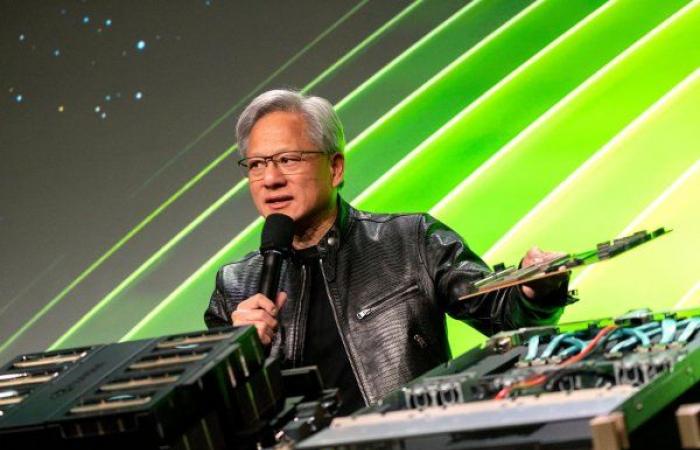
Javascript is disabled in your web browser.
Please, to view this site correctly,
enable javascript.
For instructions to enable javascript
In your browser, click here.
This Tuesday afternoon, the American semiconductor giant and global leader in the manufacture of graphics processing units (GPU), Nvidia positioned itself as the largest company by market capitalization in the world, surpassing Apple and Microsoft.
The rise of Artificial Intelligence (AI) and its derivatives, such as generative AI, drove demand for GPUs and AI hardware and software solutions developed by the company. Thus, Nvidia shares They rose yesterday up to 3.4%, placing its value around US$ 3.3 trillion (millions of millions), and becoming the most valuable in the S&P 500 indicator.
According to Bloomberg, the company, based in California, United States, controls about 80% of the accelerator chip market in AI data centers operated by AWS (Amazon), Google Cloud (Alphabet Inc) and Azure (Microsoft).
From video game technology to chips
The company was founded in 1993 by the American of Taiwanese origin – an electrical engineer from Oregon State University with a master’s degree in electrical engineering from Stanford – Jensen Huang (CEO), together with Chris Malachowsky and Curtis Priem.
In 1994, Nvidia signed its first strategic partnership with SGS-Thomson Microelectronics to manufacture the company’s single-chip graphical user interface accelerator. Thus, the following year they launched their first processor, the Nvidia NV1.
Its first years were marked by the development of 3D drivers and processors, but in its efforts to improve the quality of graphics in video games, In 1999 the company created the first GPU in history (GeForce 256), completely redesigning the computing industry, and announcing its initial public offering on the stock market at US$12 per share.
According to Bloomberg, from its debut to the moment it entered the S&P 500, Nvidia stock increased by more than 1,600%, reaching an approximate market value of US$8 billion. This growth occurred while other technology stocks collapsed after the bursting of the dotcom bubble – a period of growth in the economic values of Internet-related companies – which reached its highest point in March 2000.
The company’s initial success was due to its ability to bring its technology to video game consoles such as Xbox (Microsoft) and PlayStation (Sony). Its GeForce GPUs became coveted among gamers as they offered a more realistic experience.
In 2006, researchers at Stanford University in California discovered that GPUs could be used to speed up mathematical operations in a way that regular processing chips could not.
That same year, Nvidia launched CUDA (Compute Unified Device Architecture), a parallel computing platform and programming model that has been used in numerous desktop, laptop, professional, supercomputer GPUs, among others. This development opened the way for scientists and researchers to take advantage of the parallel processing capabilities of GPUs to solve more complex computing challenges.
According to Bloomberg, in 2008, the company’s stock plummeted due to the financial crisis, and its long-struggling competitor Advanced Micro Devices Inc. began to recover. At the same time, a deal between Nvidia and Intel, which allowed both companies to use each other’s technologies, fell through, forcing Nvidia to abandon one of its largest markets. Finally, in 2011, Intel agreed to pay Nvidia US$1.5 billion.
In 2012, Nvidia introduced graphics chips for servers in data centers. These chips were designed to perform complex computational work, such as oil and gas exploration and weather forecasting, allowing the firm to establish itself in a market that would eventually become very lucrative.
However, these chips did not sell quickly, and it took almost nine years before Nvidia stock surpassed its 2007 high, Bloomberg noted.
AI and deep learning
2012 was a key year for the beginning of the era of modern AI after the development of the neural network AlexNet, created by Alex Krizhevsky of the University of Toronto for image recognition. Under the deep learning model, the network was trained with more than one million example images that required billions of mathematical operations, accelerated by Nvidia GPUs.
The Internet ushered in the era of superhuman image recognition. Since then, the company has deep learning is used in its hardware and software to teach AI to identify images and sounds, contribute to the understanding and processing of natural language, and so that computers can establish natural dialogues, read and make summaries.
Nvidia’s AI microchips and GPUs have been used in mobile devices, supercomputers, and even data centers. Additionally, for cloud services, Its deep learning-powered GPUs are available on services from Amazon, Google, IBM, Microsoft and others.
The demand for AI
The Covid-19 pandemic boosted data center business as companies needed to purchase more computing power to support remote work. According to Bloomberg, lNvidia’s data center revenue grew eightfold from fiscal 2017 to fiscal 2021.
However, in 2022 the company’s shares fell along with the rest of the technology sector, which was dealing with rising interest rates and declining demand in the wake of the pandemic.
Although the launch of ChatGPT by OpenAI in late 2022 caused quite a stir, investors were slow to realize how Nvidia could benefit. Over time, interest in ChatGPT and other generative AI products increased, as did demand for Nvidia chips.
Its most recent forays aim to facilitate the development of quantum computing. At the beginning of the year it launched Quantum Cloud, a cloud service so researchers can test their quantum computing software.
According to Bloomberg, in the first quarter of 2023, the company projected quarterly sales that were more than 50% above the average projection. Sales to data centers surpassed its video game revenue for the first time in fiscal 2023. The agency projects that for Nvidia’s current fiscal year, those sales are expected to exceed $100 billion.





